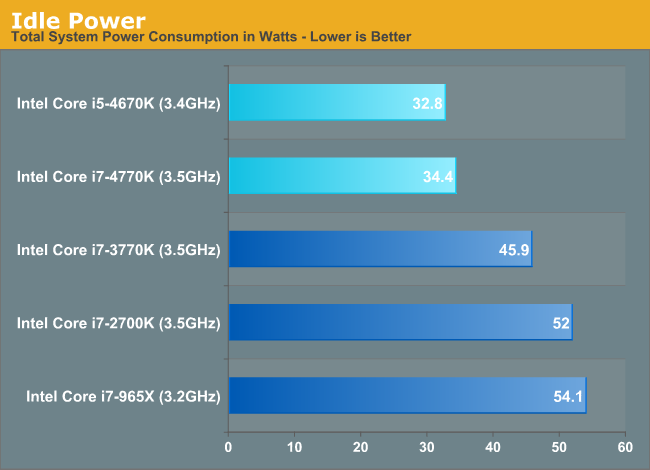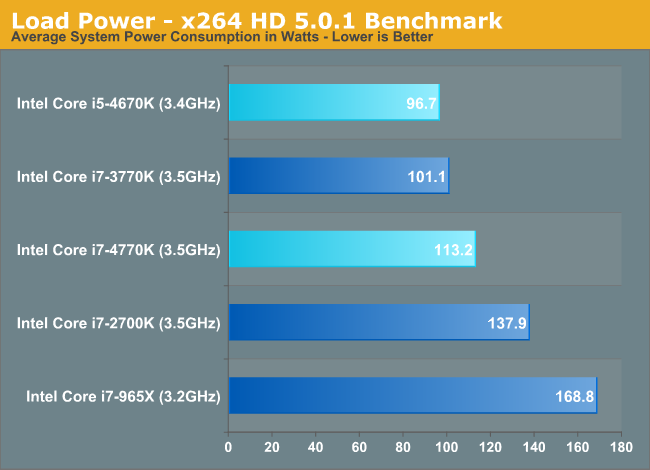The Haswell Review: Intel Core i7-4770K & i5-4670K Tested
by Anand Lal Shimpi on June 1, 2013 10:00 AM ESTPower Improvements
Although Haswell’s platform power is expected to drop considerably in mobile, particularly with Haswell U and Y SKUs (Ultrabooks and ultrathins/tablets), there are benefits to desktop Haswell parts as well.
There’s more fine grained power gating, lower chipset power and the CPU cores can transition between power states about 25% quicker than in Ivy Bridge - allowing the power control unit to be more aggressive in selecting lower power modes. We’ve also seen considerable improvements on lowering platform power consumption at the motherboard level as well. Using ASUS’ Z77 Deluxe and Z87 Deluxe motherboards for the Haswell, Ivy and Sandy Bridge CPUs, I measured significant improvements in idle power consumption:

These savings are beyond what I’d expect from Haswell alone. Intel isn’t the only one looking to make things as best as can be in the absence of any low hanging fruit. The motherboard makers are aggressively polishing their designs in order to grow their marketshare in a very difficult environment.
Under load, there’s no escaping the fact that Haswell can burn more power in pursuit of higher performance:

Here I’m showing an 11.8% increase in power consumption, and in this particular test the Core i7-4770K is 13% faster than the i7-3770K. Power consumption goes up, but so does performance per watt.
The other big part of the Haswell power story is what Intel is calling FIVR: Haswell’s Fully Integrated Voltage Regulator. Through a combination of on-die and on-package circuitry (mostly inductors on-package), Haswell assumes responsibility of distributing voltages to individual blocks and controllers (e.g. PCIe controller, memory controller, processor graphics, etc...). With FIVR, it’s easy to implement tons of voltage rails - which is why Intel doubled the number of internal voltage rails. With more independent voltage rails, there’s more fine grained control over the power delivered to various blocks of Haswell.
Thanks to a relatively high input voltage (on the order of 1.8V), it’s possible to generate quite a bit of current on-package and efficiently distribute power to all areas of the chip. Voltage ramps are 5 - 10x quicker with FIVR than with a traditional on-board voltage regulator implementation.
In order to ensure broad compatibility with memory types, there’s a second input voltage for DRAM as well.
FIVR also comes with a reduction in board area and component cost. I don’t suppose this is going to be a huge deal for desktops (admittedly the space and cost savings are basically non-existent), but it’ll mean a lot for mobile.
No S0ix for Desktop
You’ll notice that I didn’t mention any of the aggressive platform power optimizations in my sections on Haswell power management, that’s because they pretty much don’t apply here. The new active idle (S0ix) states are not supported by any of the desktop SKUs. It’s only the forthcoming Y and U series parts that support S0ix.










210 Comments
View All Comments
jmcb - Saturday, June 1, 2013 - link
I currently have an E8400 so the Haswell would be amazing....but I will go for amazing and value._zenith - Saturday, June 1, 2013 - link
"Even on the dekstop" - desktop. Just spelling gripe.I notice the gains over Nehalem are pretty much the same that you can *easily* get (just increase VCore and BCLK) out of overclocking Nehalem. So now they're neck and neck if you don't overclock the Haswell part. Maybe my system will be good for another year now! (i7-920 @ 4.0).
Da W - Saturday, June 1, 2013 - link
YeehaaaNow i can buy my Trinity + Radeon rig for the price of a haswell only rig. I know it will play every videogame made for xbox or PS4 for the next 7-8 years and make a perfect HTPC!
ChefJeff789 - Saturday, June 1, 2013 - link
I've been sitting on a first-gen Core i7 and this is still a little dissapointing. It is significantly quicker than mine, but I'm not sure that the upgrade is quite worth it for me yet as everything I use runs reasonably well. I am interested in the new socket type, though. I wonder if upgrading the motherboard with a decent Haswell would benefit me later on with a Skylake. It's hard to say; I haven't seen any firm specs on the socket-type for the Skylake chips.jwcalla - Saturday, June 1, 2013 - link
At this point I think there are more interesting places to put your tech dollars. A high-DPI display or triple monitors if you're into gaming, more SSDs if you need the space, a NAS or a nice tablet, etc. I'm in your camp with an i7-870 and nothing I do pushes it enough to test my patience.kyuu - Saturday, June 1, 2013 - link
Agreed -- unless you're loaded, there are far more interesting ways to spend your money in the PC arena than on the overhyped and underwhelming Haswell SKUs. Unless you're still stuck on Phenom II or Core2Duo.bji - Sunday, June 2, 2013 - link
Hey - I'm still "stuck" on a Phenom II (in my desktop; laptop is 15 inch rMBP with Ivy Bridge) and it's not that bad. It's significantly slower than the Bridges in single threaded apps but even so it's fast enough that I never notice, much like jwcalla never notices with his i7-870. And the Phenom II x6 has 6 real cores that do decently well in heavily multithreaded apps, really extensive compiles being the only thing that I ever do that would benefit at all from extra speed. 6 real cores holding their own reasonably well there. Even if an Ivy Bridge were 50% faster per core on the compiles (and it probably is), the x6 has 50% more cores so it kind of evens out ...rabbatabba - Sunday, June 2, 2013 - link
Anyone know if x264 is properly optimized for AVX2? Naiively, one might expect a 2x speedup for SIMD integer dominated code over the AVX1-only 2700k provided that the rest of the system is able to shuffle around data.http://com3.tv/wp-content/uploads/2012/09/Haswell-...
I am very curious as to the real-world performance gains of integer (and floating-point FMA) SIMD code in Haswell compared to previous generations.
Klimax - Sunday, June 2, 2013 - link
It has support for AVX2. Not sure in how many places, but over months there was stream of AVX2 code paths.plopingo - Sunday, June 2, 2013 - link
No need for me to upgrade with my I7 960@4.2ghzmaybe next time :D